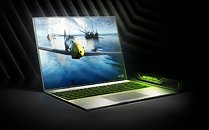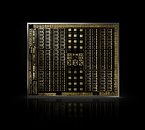Thursday, January 31st 2019

Mobile NVIDIA GeForce RTX GPUs Will Vary Wildly in Performance, Clocks Lowered Substantially
NVIDIA is in the process of rolling out the first implementations of its RTX 2000 series GPUs in mobile form, and if the going is as is being reported, it's going to be a little rough for users to actually extrapolate their performance from product to product. This is because manufacturers are apparently getting a whole lot of leeway in how to clock their products, according to their solution's thermal characteristics and design philosophy.
What this means is that NVIDIA's RTX 2080 Max-Q, for example, can be clocked as low as 735 MHz, which is a more than 50% downclock from its desktop counterpart (1,515 MHz). The non-Max-Q implementation of NVIDIA's RTX 2080, for now, seems to be clocked at around 1,380 MHz, which is still a close to 200 Mhz downclock. Of course, these lowered clocks are absolutely normal - and necessary - for these products, particularly on a huge chip such as the one powering the RTX 2080. The problem arises when manufacturers don't disclose clockspeeds of the GPU in their particular implementation - a user might buy, say, an MSI laptop and an ASUS one with the exact same apparent configuration, but GPUs operating at very different clockspeeds, with very different levels of performance. Users should do their due research when it comes to the point of choosing what mobile solution sporting one of these NVIDIA GPUs they should choose.
Sources:
TechSpot, Tweakers.net
What this means is that NVIDIA's RTX 2080 Max-Q, for example, can be clocked as low as 735 MHz, which is a more than 50% downclock from its desktop counterpart (1,515 MHz). The non-Max-Q implementation of NVIDIA's RTX 2080, for now, seems to be clocked at around 1,380 MHz, which is still a close to 200 Mhz downclock. Of course, these lowered clocks are absolutely normal - and necessary - for these products, particularly on a huge chip such as the one powering the RTX 2080. The problem arises when manufacturers don't disclose clockspeeds of the GPU in their particular implementation - a user might buy, say, an MSI laptop and an ASUS one with the exact same apparent configuration, but GPUs operating at very different clockspeeds, with very different levels of performance. Users should do their due research when it comes to the point of choosing what mobile solution sporting one of these NVIDIA GPUs they should choose.




100 Comments on Mobile NVIDIA GeForce RTX GPUs Will Vary Wildly in Performance, Clocks Lowered Substantially
Whats funny is that the fully fledged RTX 2080 in the P775TM1 was only around 20FPS faster than the 1080 in the same laptop, both 9900K's/32GB RAM and 150W TDP
We can debate Darwinism and while I fully agree that people are required to do their research/due diligence, I still think its a horrible practice.
As for 'how should they do it'... simple. Get the closest performing desktop equivalent model name and put that sticker on your laptop part. That goes for both the Max-Q's and the regular variants. If I recall, Nvidia used to put an "M" at the end until Pascal. That was also a distinction less deceptive than the way they are marketing it since Max-Q launched.
People should be doing that all the time.No. It doesn't work like that. There's no such thing as DXR off. That core is part of the chip.
This stupid article is just getting people to argue about stupid things that's obvious. The performance will vary because some laptops have bad cooling etc.Thank god there's someone that understands...
Makes me miss the days of the Clevo X7200 and the M17X R2..
I have no problem with them selling the same chip in a graphics card and a laptop and having the same branding. And Max-Q is just a factory underclocked and undervolted part. I do agree that they need to have a better distinction between the performance levels, but there's a reason they don't put an "m" after these chips. They are the desktop chips in a mobile form factor.
On the surface the MX150 is a 25w cheap mobile card that theoretically should outperform its desktop counterpart (GT 1030) by a solid 5-10%. However the most prevalent version of the MX150 was actually a version limited to an 8w TDP. I have such a laptop with one of these, and in stock configuration it is almost worse than having Intel graphics - and that is because it starts jumping between 500MHz and 1200MHz after 5 min of gaming (causing immense stutter).
However if you force clocks to stay at 1150MHz, overclock the memory, and undervolt it substantially - it can actually match the GT 1030 within an 8w profile. Very cool - but annoying for non-overclockers. I expect the same of these RTX Laptop cards.
Nvidia wants to be able to say they can fit a GTX 2060 in an ultrabook...... even if it will perform like an AMD APU under prolonged load lol. But to those up to the challenge, I bet you can get it close to 1070 performance after undervolting.Even funnier was the GTX 480m was a GTX 465 running at (no joke) only around 300-400MHz if I remember correctly lol. It had incredible reliability and overheating issues (like all of Fermi) while also only really being usable in laptops the size of a desktop.
Lets hope that memory or IMC wont die in these too.
You can get a proper 1070 MXM card for around the $500 mark, still not great, but GL finding a laptop with a 1070 for around $500
We can compare the models by series ... in which case the 2080 will likely use more power than the 1080. But the apples and apples comparison must be on the basis of performance delivered ... in which the 2080 should be compared with something close in performance such as the 1080 Ti
MSI 1080 Ti Gaming = 282 watts peak gaming per TPU testing
MSI 2080 Gaming = 244 watts peak gaming per TPU testing
Of course manufacturers and vendors will do their best to hide which of the 20X0 series GPU is being used. And nVidia is supplying what their cleints are asking for, people are going to choose a stylish laptop and will want 2080 performance. The ones who won'tlook poast the web price or store placard will go home with a thin mas market lappie with a heavily downclocked 2080 . Others will spend less on a well designed, preferably custom built laptop with a hefty cooling system and a 2070 with similar performance.
Be like an engineer, forget about "sexy" thin laptops, purchase from a quality outfit known for high performance, or better yet "custom built" and verify that you are getting what you want.... If it doesn't weight 5.5 pounds (15") or 7.5_ pounds (17"), it's not likely going to support Qmax AND deliver long battery life
RTX-OPS - 37T versus T53T
Giga Rays/s - 5 versus 7
Boost Clock (MHz) - 1095 versus 1590
Base Clock (MHz) - 735 versus 1380
Thermal Design Power - 80 W versus 150+ W
Here's MSI's offerings ... had to configure more than Id like extras wise to get apples and apples.
MSI GS75 Stealth 202- $3,227
17.3" FHD, IPS-Level 144Hz 3ms 100%sRGB 72%NTSC
NVIDIA GeForce RTX 2080 8GB GDDR6 w/ Qmax
8th Generation Intel® Core™ Coffee Lake i7-8750H
16GB (1x16GB) DDR4 2666MHz SO-DIMM Memory
512GB Samsung 970 PRO M.2 NVMe Solid State Drive
2TB Western Digital BLUE SATA III Solid State Disk Drive
802.11AC wireless LAN + Bluetooth
4.96 lbs with 4-cell Battery
MSI GE75 Raider 048 - $3,198
17.3" FHD, IPS-Level 144Hz 3ms 100%sRGB 72%NTSC
NVIDIA GeForce RTX 2080 8GB GDDR6
8th Generation Intel® Core™ Coffee Lake i7-8750H
16GB (1x16GB) DDR4 2666MHz SO-DIMM Memory
512GB Samsung 970 PRO M.2 NVMe Solid State Drive
2TB Western Digital BLUE SATA III Solid State Disk Drive
802.11AC wireless LAN + Bluetooth
5.75 lbs with 6-cell Battery
So the QMax is an extra $29 but battey is smaller ... Id be concerned about the extra power combinerd with smaller power and perhaps less robust cooling.